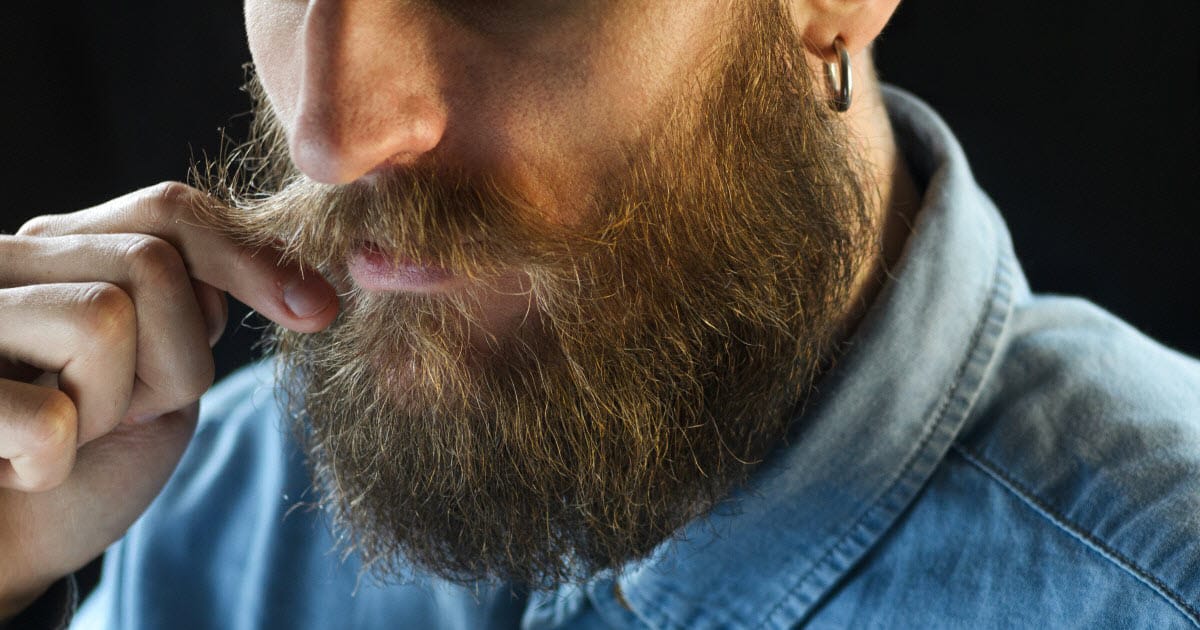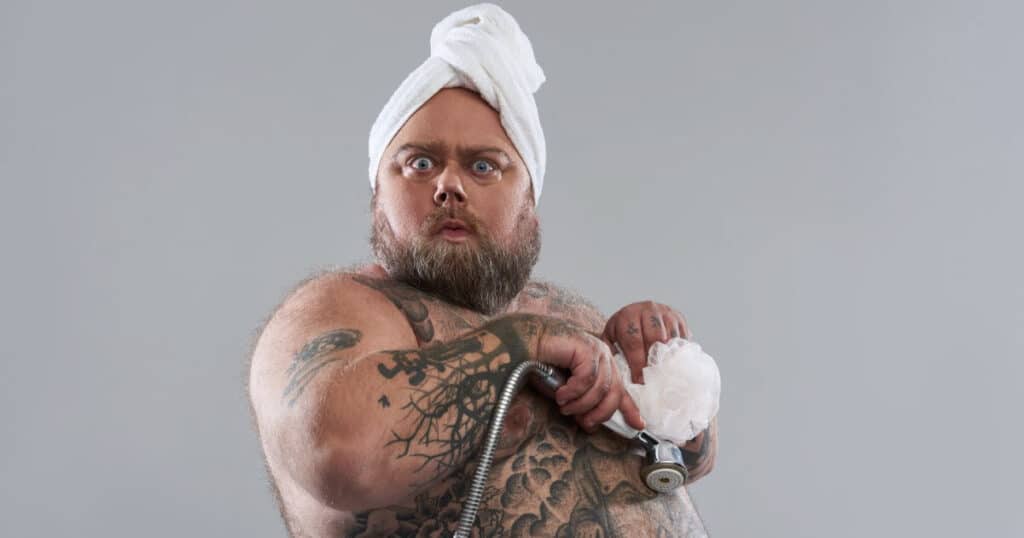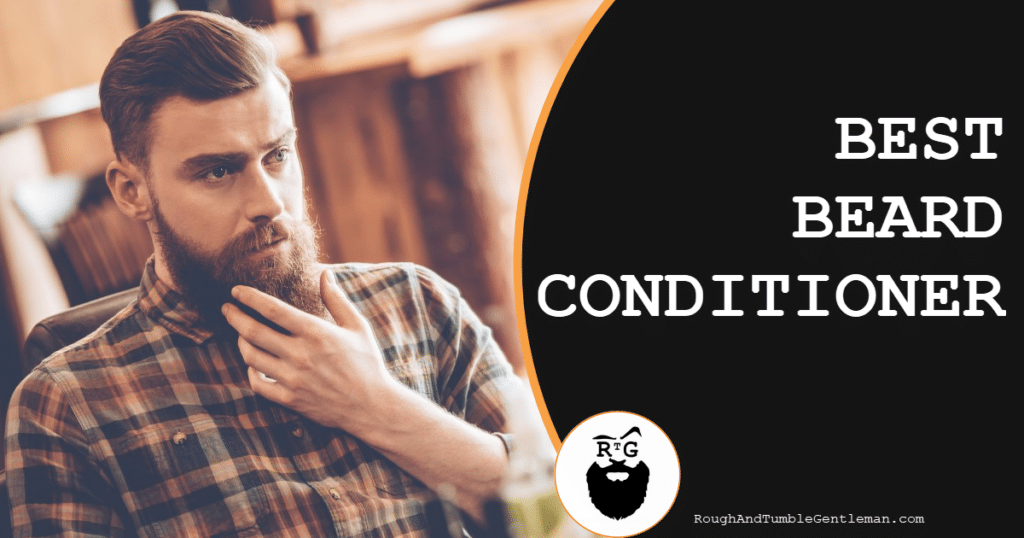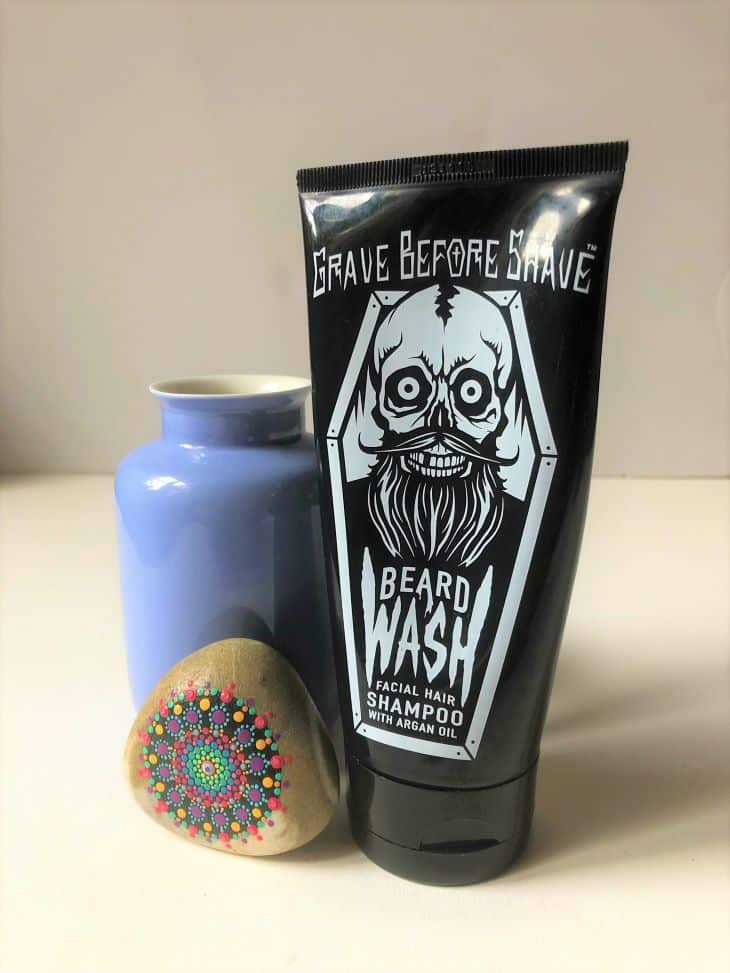One of the wonderful things you discover when you grow out your beard is that there are hundreds—literally hundreds—of fantastic-smelling products you can use to gussy-up your facial hair. Beard balms, beard oils, beard conditioners—there are a LOT of options to choose from.
After a while, though, all those fantastic products can pose a bit of problem. Check out our current stash of beard conditioners and other products:
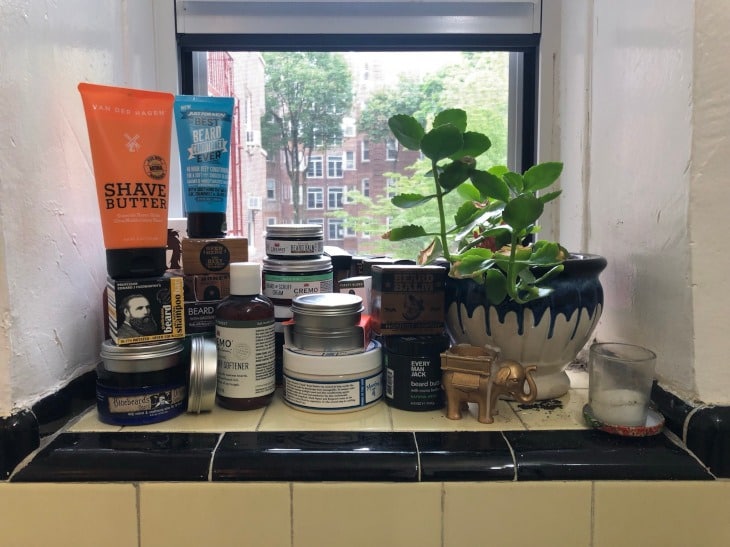
That’s a lot of beard products—too many, some might say! And not a single one of them is a DIY beard conditioner. Not only will we never get around to using all this stuff (and it takes up a lot of space), but it can get pricey—these items are individually usually inexpensive, but together, they all add up.
So, you may eventually want to start making your own beard products. One of the easiest beard products to make is a beard conditioner—you can get it the exact consistency that you like, and incorporate whatever scents you want, and whatever skin-care compounds you want to include.
Here’s our favorite DIY beard conditioner recipes, along with our guide that walks you through how to make beard conditioner at home.
We’ll tell you what a beard conditioner is supposed to do, some tricks we’ve learned as we explain how to make these natural and homemade beard softener products, and how to alter the recipe if you want to mix things up a bit.
The beard conditioner recipes we’ll share today are super-simple and they don’t require any special pieces of equipment like double-boilers or pipettes or anything crazy.
We’ll start with some helpful info and then dive in:
What a Beard Conditioner is Supposed to Do
A well-formulated beard conditioner is not unlike the conditioner you’d use in the hair on your head, and one of its main purposes is to soften facial hair and make it smooth—but it’s also got a few other jobs:
- It should hydrate your skin. Here’s a secret about almost all beard products: you think they’re about your beard, but they’re actually about helping the skin under your beard. A good beard conditioner should have ingredients that keep your skin from getting dry and irritated.
- It should relieve itchiness. Ask most men their #1 issue with their beard, and they’ll likely tell you it’s that awful itchy/scratchy feeling it has as it grows out. Many of the ingredients in a beard conditioner are included to alleviate that feeling.
- It should help you untangle knots. Left on its own, a beard can become a tangled mess. A conditioner should include some silky ingredients to make your facial hair smooth and loose, helping you keep it combed and decent-looking.
There you have it! That’s the jist of it, but there’s one other question that most guys have when it comes to conditioners: how is it different than any other beard product?
How Beard Conditioner Differs from Other Products
- Beard conditioner vs. beard shampoo. Shampoo is a cleansing agent—it’s there to wash and clean and get particles (dirt, oils, etc.) out of your facial hair. Beard conditioner doesn’t really have the cleansing agents that a beard shampoo has (and that’s why you should never cleanse your beard with a beard conditioner—and why you should never cleanse the hair on your head with a hair conditioner). Beard shampoo is for cleansing, beard conditioner is for smooth, untangling, etc.
- Beard conditioner vs. beard balm. This can get tricky, because guys sometimes use these terms interchangeably. As a general rule of thumb, there are two types of beard conditioners: ones you use in the shower and wash out (and these are what most people refer to when they say “beard conditioner”), and ones you use after the shower and leave in your beard (and these are usually called “beard balms”). Most of the time, when someone says “beard conditioner,” they mean the type you use in the shower and wash out. Below, we’ll give you a beard conditioner recipe for each type.
And there you have it! With that little bit of knowledge, you know more than 95% of bearded guys. Seriously, we get that question—“how is beard conditioner different from beard balm?” a couple of times a week. Now you know!

Basic Ingredients in a DIY Beard Conditioner
So what’s in a beard conditioner? Before we jump into the recipes, you should know what’ll go in it.
The recipes vary, but most usually have the following:
- An oil and/or a butter,
- A scent, and
- Nutrients.
Let’s examine the importance of each of these more closely:
An Oil and/or a Butter
Remember a moment ago, when we mentioned that there are “in-shower” beard conditioners that you rinse out, and “after-your-shower” conditioners that you apply after you wash up? Those two formulations have different ingredient sets.
An “in-the-shower” beard conditioner is usually mostly oils. Olive oil, argan oil, coconut oil—you’ll hear about all sorts of possible fat-based ingredients for conditioning your beard. And to an extent, many of them work great, because oil is hydrophobic, and helps your beard hold on to its natural moisture.
An “after-you-shower” beard conditioner that you leave in will usually include oils, but usually also have one or more “butters.” These aren’t the type of butter that you’d put on bread, but rather mashed up seeds and nuts from various plants. Butters have a semi-solid consistency, and when combined with oils, they create a pleasant-feeling material. The three types of butter that are most common in beard products are shea butter, cocoa butter, and mango butter. Both have a ton of fantastic ingredients that benefit skin and hair, and both do a great job moisturizing beards. “After-you-shower” beard conditioners sometimes also include a very small amount of waxes, to give the conditioner some “hold” and keep your beard in place.
A Scent
Over the last couple of years, you’ve probably heard a lot about “essential oils,” and how magical they are. Here’s the bad news: they’re not magical. They’re just oils, and you can read more about them here. Here’s the good news: a lot of them smell great, and are used to make beard products smell fantastic. We’ve included a few scents you can include below, and how to incorporate them into your beard conditioner. BTW: you may hear the term “naked” in relation to beard products (as in, a “naked
Nutrients
One of the main benefits of a beard conditioner is to make your beard healthy from the inside out, and to do that, you’ll need nutrients. Vitamin E oil is a very common ingredient in beard products, because it can fortify skin and rejuvenate skin—great advantages when you’re using a beard conditioner. By the way, we like RejuveNaturals Vitamin E Oil—it’s all-natural, not too sticky, and vegan/gluten-free.
How to Make Your Own Beard Conditioner
Ready to get started? Here are the two types of beard conditioners you can make. We’ll start with the “in-shower” version, because it’s really simple to concoct:
Our DIY Beard Conditioner for In-Shower Use
This is really, really easy, and very quick. Here’s what you need:
Ingredients:
- 3 tablespoons of coconut oil. This is a thicker oil, and acts as a base for the other ingredients. There are a lot of coconut oils out there, but we’ve had good experiences with Viva Natural Organic Coconut Oil.
- 1/2 tablespoon of jojoba oil. “Jojoba” sounds silly, but it’s actually jam-packed with nutrients that are good for your skin. We use Leven Rose Jojoba Oil, because they actually make a line of beard oils called “Ranger.”
- 1/4 tablespoon of argan oil. Argan oil isn’t too fancy—it’s a pretty common oil in a lot of beard conditioners—but it’s great for mixing all these ingredients together. We’ve had good luck with Kate Blanc Argan Oil—Kate Blanc mostly makes cosmetics, but this is great for beards.
- 4 or 5 drops of cedarwood oil. Cedarwood oil has an outdoorsy, masculine smell, and it’s one of our favorite scents to use in a beard conditioner. We like UpNature Cedarwood Oil.
This makes a relatively small amount of beard conditioner—good for only a few uses in the shower—so feel free to double or triple the amounts if you want to make a bigger batch.
Instructions:
- Melt the coconut oil either in a microwave (super easy) or a in a saucepan on your kitchen stove, and whichever you use, make sure you don’t “cook” it—you want to warm it up and loosen it, not boil it.
- After you’re done, stir it up a bit, and add in the other oils (the jojoba oil, the argan oil, and the cedarwood oil), and keep stirring. It may cool a little bit; that’s fine.
- When you’re ready—and before the mixture sets—pour it into a container. You can pour into it in an old jam jar, a plastic pump bottle, or a decorative bottle—whatever you want. Just be careful with glass—if you’re bringing the beard conditioner into the shower with you, you don’t want it falling on the floor and shattering.
- And… that’s it! Easy peasy. Let it cool, and then bring it into the shower with you, or make a big batch of it and give it away as gifts.
How to Use It in the Shower:
Make sure the water in your shower is warm—hot is even better—and work a dollop of the conditioner into your beard. Let it sit for a few minutes—two or three is more than enough—so that your beard has a chance to absorb the ingredients. After that, rise it out and enjoy what should be a softer, fresher-smelling beard. Nice!
Our DIY Beard Conditioner for After-Shower Use
This is a little more challenging to make, but not by much—the recipe is just a bit longer.
Ingredients:
- 8 tablespoons of coconut oil. This is the “base” ingredient, and it gives the conditioner consistency.
- 4 tablespoons of argan oil. You can actually use olive oil if you don’t have argan oil, and most of us have that lying around the house. It’s got no real smell, and it’s a great moisturizer.
- 4 tablespoons of shea butter. Green Leaf Naturals Shea Butter is our go-to shea butter for this kind of project, but you can use any kind of cocoa butter or shea butter as well.
- 2 tablespoons of beeswax. This will give your beard conditioner some “staying power” throughout the day, and allow you sculpt your beard a little bit. If you find that you like the “hold” that beeswax can provide, feel free to experiment and give use more than listed (just remember that too much beeswax will make the conditioner very difficult to apply—and very difficult to remove!).
- 5 drops of Vitamin E oil. We mentioned this earlier, but Vitamin E oil has some *incredible* benefits to skin and hair. Five drops are enough to get those benefits without harming the conditioner itself.
- 5 to 8 drops of cedarwood oil. We <big heart> the scent of cedarwood oil, but sandalwood oil is a very common alternative—it has that clean “barbershop” smell that a lot of beard products feature. Our go-to sandalwood oil is Gya Labs Sandalwood. You can use other scents, too, and we discuss that a bit later.
Instructions:
- Heat the coconut oil, the argan oil (or olive oil if you used that instead), the shea butter (or mango or cocoa), and beeswax in the microwave or in a saucepan on your stovetop. Melt them together until all the ingredients are loose and it looks like you can mix them together.
- Set it aside and let it cool for a short while—maybe a minute or two—and then add in the Vitamin E oil and the cedarwood oil/sandalwood oil/whatever you used for scent.
- Mix it all together as well as you can. If you have a handheld mixer, that works great. Mix it together for a few minutes (and don’t be surprised if your hands and wrists and forearms get a little sore—mixing things in a bowl takes a surprising amount of effort!).
- Let it sit for a while, and pour/transfer the mixture into the container of your choice. Wallah! You’re good to go.
How to Use It After Your Shower:
This one is pretty easy:
- First, shower and dry off after you get out of the shower.
- Next, take a small dollop of the beard conditioner—a scoop the size of a peanut or an almond—and work it into your beard. Be sure to rub it into all parts of your beard—your mustache, your goatee area, and beneath your ears at your sideburns—and use a beard comb if you need a little help. Those things can be very useful.
- Finally, go about your day and enjoy your beard!

How to Create Different Scents for Your Beard Conditioner
Above, we used cedarwood and/or sandalwood to give the beard conditioner scent, but that’s just what we like—you can use a wide range of scents, and develop your own “signature scent” that’s all your own.
Here are some other essential oils that are popular among bearded folks:
- Lemon oil. Bright, perky, and fun—that lemon scent is unmistakable, and it’s a great scent for a clean smell.
- Bergamot oil. This is actually a citrus scent, that’s somewhere between an orange and a lemon—we find it to be very pleasant.
- Pine oil. Cedarwood is “moderately” woodsy, whereas pine oil is “pop-you-in-the-face” woodsy. It’s an aromatic, bright scent.
- Eucalyptus. A cooling, fresh scent—this is a nice, relaxed scent that’s not too pushy.
- Rosemary. Most people equate rosemary with cooking scents, but it’s quite nice on its own—sweet, a little earthy, very unique. You could make something very interesting with this, if you experimented a bit.
- Cinnamon bark. Lively, bright, and spicy—another recognizable, sweet aroma.
There are, of course, a wide range of essential oils that you can pick out for your scent, and you can use any one that interests you. A quick word of warning, though: don’t go overboard with essential oil. It’s the sort of thing where “a little bit goes a long way.” Start slow and build, find what you like, and if you find that your skin has a reaction to it, back off.
Enjoy Your Beard Conditioner!
There’s something really enjoyable about making your own grooming products—not only can you control what ingredients you use (and be certain you’re using high-quality, organic ones)—there’s something deeply satisfying about the self-sufficiency that comes with making your own goods. We have a few friends who got started making their own beard conditioner, and now make most of their own grooming products. It can be a really life-affirming thing.
And, if you get really good at it—and you have a mind for business—who knows? Maybe you could start your own line of beard conditioners! (note: success not guaranteed!).
Alright, that’s it from us—hopefully the recipes above work for you, and if they do, we’d love to hear about it. Hop over to our “Contact” page and drops a line.
That’s it for now—good luck, have fun, and happy beard!
Michael Morris is the head writer here at Rough and Tumble Gentleman. He's got a ducktail beard and loves Brazilian jiu-jitsu. He's married to the woman of his dreams and lives in Brooklyn, NY.

